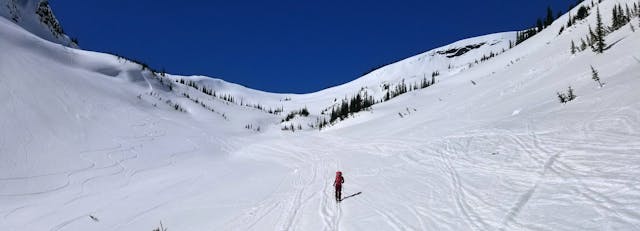- Date
- Thursday, April 25, 2024
- Author
- Mike Conlan, Avalanche Forecaster
- Tagged under
April 25 is the last day of daily avalanche forecasts in Avalanche Canada’s forecast regions. Danger ratings expire on April 28 and as of April 29, Avalanche Canada’s forecast regions will list Spring Conditions.

Spring is the time of year when conditions can change in the matter of hours. The weather can switch from a wintry storm to intense summer heat quickly, which rapidly affects the snowpack and avalanche conditions.
Although the daily avalanche forecasts for our regions are finished for the season, there are still some great resources to help you plan for a safe day in the backcountry:
- Our Spring Guidance can help you plan for the various conditions you may come across this spring. It breaks the spring up into four scenarios, based on the weather, snowpack, potential avalanche activity, and associated terrain and travel advice. This is the go-to for spring travel in avalanche terrain.
- The Mountain Information Network hosts observations by fellow recreationists. The blue pins on the avalanche.ca homepage show the shared information. If you do head into the backcountry, please consider submitting your observations to help others. Even just a photograph helps.
- Look for nearby Mountain Condition Reports on the homepage too. They show up as blue pins, but with white circles inside them. These reports include high-quality data, submitted by certified professional guides.
- Check the Snowpack Summary section for your region of interest on avalanche.ca for a generalized description of the snowpack.
- The Dangerator can be a helpful tool to assess for potential avalanche danger if conditions are wintry.
- Review the information on the Mountain Weather Forecast page and associated weather products to understand what weather conditions you may experience during your travels. Although the text that summarizes the information may not be available mid-spring into the summer, the graphics can still provide valuable insights.
Terrain and travel advice will vary for a given day and location, but here are some general tips for safe travel in the spring:
- Aim to start your day early and end your day early, particularly during warm, sunny days. Sun-exposed slopes could quickly form wet-related avalanches and cornices could weaken and fail with daytime warming.
- If it is stormy, expect storm slab and wind slab avalanche problems at higher elevations. Dial back your terrain choices and give some time for the new snow to bond, particularly if it is sitting on hard, smooth surfaces.
- Expect to find very different conditions with elevation and aspect. The snow may be a hard, melting brick below treeline, but a cold snowpack with weak layers may exist in the alpine. Dry snow may persist on shaded slopes while sunny slopes bake in the sun.
Get at it safely, make some memories, and please report your findings to the MIN to help the backcountry community. We’ll see you in November!
